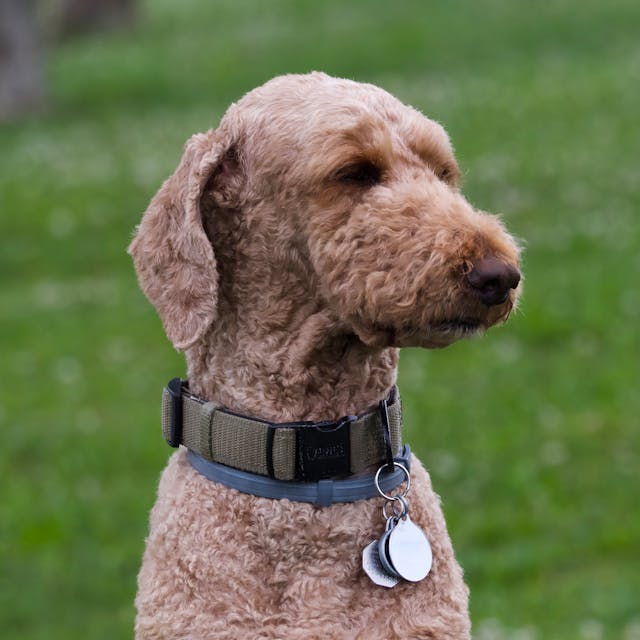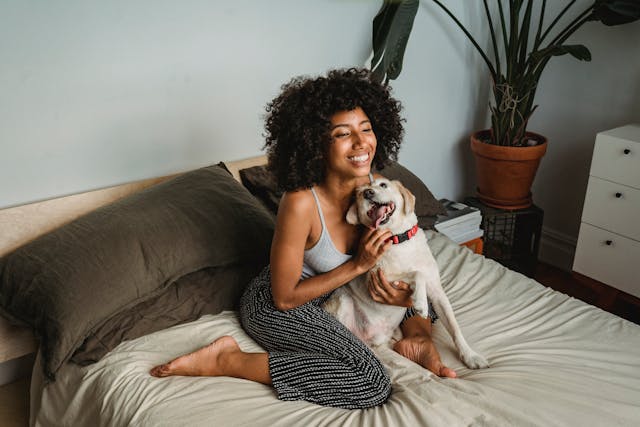The moment I first left my Labradoodle alone, his pleading, worried eyes stayed with me all day. Labradoodle separation anxiety is a real nightmare for them. Many owners don’t realize how deep a bond their Labradoodle forms until they notice the destructive signs of separation. From loud barking to unexpected potty accidents, their reactions can be heartbreaking. I’ve seen cases where a dog’s behavior becomes so intense, it leads to self-injury.
That’s when I knew this wasn’t just about training—it was about emotional support. At Snowy River Labradoodles, I learned that understanding your dog’s need to feel secure and independent is key. Every scene of your departure—your bag in hand, the door creaking open—can trigger anxiety, making your furry friend feel like they’re being left behind in a storm.
As someone who’s worked with clients navigating these struggles, I’ve found that even the most affectionate, well-raised dogs can show symptoms when left alone. It often starts subtly and can manifest more seriously over time. Recognizing the condition early helps build lasting coping skills. One common tip I give is to create a calm routine before stepping out for work. A consistent pattern gives your dog predictability. This may sound simple, but it builds guidance into your daily rhythm. When your furry companion sees you act with calm, they feel it too.
Over time, those once-nervous mornings fade, replaced by quiet confidence. The challenge is real, but with patience and expert help, even an Australian Labradoodle can learn to face your absence without fear.
Table of Contents

Understanding Labradoodle Separation Anxiety
If you’ve ever owned Australian Labradoodles, you already know how deeply they connect with their human family. These affectionate, devoted pets are known as velcro dogs—they stick by your side, follow you from room to room, and crave constant interaction. But this intense attachment can lead to separation anxiety, a very common issue in the breed. As someone who has raised several Labradoodles, I’ve seen firsthand how their loyal and loving nature can become a challenge when they’re left alone. They may show anxious behaviors like pacing, whining, or even chewing on furniture—not because they’re bad, but because they’re feeling real distress and loneliness.
What makes them so sensitive? It’s their strong emotional makeup and their unique characteristics passed down from their Labrador Retriever and Poodle parents. These intelligent, social dogs thrive on companionship. A lack of proper socialization or previous traumatic experiences can make things worse, increasing their dependence on their caregivers. These aren’t just surface-level behaviors; they’re deep-rooted responses tied to the dog’s need to feel safe. As an experienced owner, I’ve found that with patience and understanding, these traits can be managed. You just need to start by decoding their behavior and giving them the structure and love they’re naturally drawn to.
Signs and Symptoms: Recognizing Separation Anxiety in Your Dog
Recognizing separation anxiety in your Australian Labradoodle is crucial for providing them with the right care. The signs can vary, but they all stem from a deep emotional need to stay close to their dog owner. Here are the most common indicators you should be aware of:
- Excessive Barking or Howling
- This is often the first sign of anxiety. Your Labradoodle may bark or howl non-stop when you leave the room or the house.
- They might even try to seek attention by vocalizing in an attempt to ease their stress.
- Destructive Behavior
- Chewing furniture, scratching doors, or digging are common behaviors that show your dog’s anxiety.
- The urge to escape from a confined space like a crate or room can also be a sign they want to reunite with you.
- Potty Accidents
- Even if your dog is normally house-trained, the stress from separation can lead to accidents indoors.
- Stress-induced potty accidents are common and should not be ignored.
- Pacing and Restlessness
- If your dog is pacing or moving around restlessly when left alone, it’s a clear indication of anxiety.
- This inability to settle down often accompanies other symptoms like drooling or whining.
- Attempts to Escape
- Your Labradoodle might try to break free from their crate or room to find you.
- This is often driven by their overwhelming need to reunite with their human family.
- Physical Symptoms
- Panting, drooling, or even vomiting can be physical manifestations of anxiety.
- A loss of appetite or nausea when you’re away are clear signs of distress.
- Following You Everywhere
- Labradoodles often try to follow you around the house, unable to be left alone for even short periods.
- They may act clingy or overly dependent, which is a classic sign of separation anxiety.
Recognizing these symptoms early is essential for addressing the problem effectively. It helps in creating a more secure environment for your dog, and with the right training, you can ease their anxiety and give them the confidence they need when you’re not around.
Debunking Myths: Common Misconceptions About Separation Anxiety
Myth 1: All Labradoodles will develop separation anxiety
Not all Labradoodles will develop separation anxiety. Though their affectionate nature and intelligence can make them more prone to this condition, it’s actually their individual temperament, upbringing, and training that influence whether or not they experience separation anxiety. This means that with the right care and attention, many Labradoodles can avoid the problem entirely.
Myth 2: Separation anxiety is a sign of disobedience
It’s a common myth that separation anxiety is linked to disobedience, but this is not the case. Separation anxiety is a psychological condition caused by fear and stress when left alone, not a deliberate attempt to misbehave. The behavior should be viewed with empathy and understanding, rather than with anger or punishment.
Myth 3: Leaving more toys and treats will cure separation anxiety
Providing toys and treats may distract your Labradoodle, but they won’t solve the root cause of separation anxiety. These distractions can temporarily ease anxiety, but separation anxiety needs to be addressed through training, behavior modification, and proper care to really make a difference.

Setting Up for Success: Breeder’s Tips for Prevention
Preventing separation anxiety in your Labradoodle starts the moment you bring them home. It’s important to begin early training to establish a consistent routine. By working with a reputable breeder, like Royal Australian Labradoodles, you ensure you’re on the right track from the start. Labradoodle puppies need a structured, predictable environment to build their confidence and feel secure. A routine that includes meal times, playtime, exercise, and rest is key to helping your puppy feel settled and happy.
In addition to a routine, independence training is vital. Begin by giving your Labradoodle short periods of alone time, even when you’re home. A crate or a designated space can help them learn to entertain themselves and gradually become comfortable being by themselves. Over time, you can extend the periods of alone time, giving your dog the confidence to handle being away from you without anxiety.
Socialization Foundations: A Breeder’s Silent Role
One thing many new dog owners overlook is how early socialization shapes a Labradoodle’s entire emotional world. I remember when I picked up my puppy from Royal Australian Labradoodles—their careful exposure to different people, environments, and situations was already visible. My pup wasn’t anxious or shy but confident and alert. A responsible breeder doesn’t just hand you a dog; they begin your journey by introducing mental and physical stimulation from those first few weeks. Programs like Puppy Culture and the “Super Dog” Program—which start as early as Day 3 and continue through Day 15—are powerful tools used to build resilience and prevent anxiety-related issues such as separation anxiety.
Through consistent, positive, and varied social experiences, a Labradoodle puppy learns how to adapt, becoming a well-adjusted adult. These early developmental stages are a golden window for growth. Confidence isn’t taught later—it’s nurtured from birth. As a trainer, I always advise future pet parents to prioritize socialization when choosing a breeder, because that unseen effort lays the groundwork for a lifetime of emotional balance. When socialization is embedded into a breeding program, anxiety doesn’t stand a chance.
Environment Setup: Creating a Safe and Anxiety-Free Space
A Peaceful Place to Call Their Own
Helping your Labradoodle feel secure starts with how you shape their environment. I’ve raised dogs for years, and one thing I’ve learned is that a safe and anxiety-free setting makes a huge difference. Puppies from responsible breeders like Royal Australian Labradoodles already get a strong start, but what you do at home matters just as much. Set up a comfortable crate or designated area that becomes their personal zone. Add a soft bed, favorite toys, and fresh water. Keep departures and arrivals calm—no big fuss—so you don’t heighten their emotions. This helps your Labradoodle associate being alone with peace rather than panic.
Tools and Tips That Work
To prevent separation anxiety, I also recommend interactive toys that offer mental stimulation. My Labradoodle loves puzzles and treat-dispensing toys—they keep her busy and entertained when I’m not around. Start with short periods of alone time and slowly extend the duration, always rewarding calm behavior. If your dog still struggles, look into doggy daycare or a dog walker for extra companionship. These breeder-recommended strategies build a solid foundation for emotional health and truly help reduce long-term stress in your pet’s life.
Advanced Strategies for Alleviating Anxiety
Behavioral Training Techniques: Rewards-Based Training and Desensitization
When I first noticed separation anxiety in my Australian Labradoodle, I was overwhelmed. She would panic during even the shortest departures. After some research and talking to a veterinarian, I found that rewards-based training and desensitization were highly effective. I started using positive reinforcement by giving her treats, praise, and affection every time she remained calm while I prepared to leave. These small moments built her confidence and slowly created a positive association with my absence.
I practiced leaving the house for a brief amount of time—just a minute or two—and then increased the duration bit by bit. This gradual exposure helped her become accustomed to being alone. Over time, I noticed she became more balanced, less anxious, and more relaxed overall. Consistency was key, and sticking with this daily helped bring about lasting change. Now she waits by the door peacefully, knowing I’ll return.
Health and Nutrition: Understanding the Impact of Diet on Your Labradoodle’s Mental Health
I never realized how much my Labradoodle’s diet could impact her emotions. After switching her to high-quality food filled with essential nutrients like Omega-3 fatty acids, I saw a major change. Her mood improved, and her anxious behavior started to fade. I also added some dietary supplements after getting approval from my veterinarian. It’s amazing how much a well-balanced meal can contribute to mental health.
Another thing I learned was the importance of hydration. Ensuring she had access to fresh water at all times kept her more comfortable and stable throughout the day. Small habits like checking her bowl regularly made a big difference. Nutrition truly works hand-in-hand with emotional well-being, and paying attention to it gave her the strength she needed to feel secure and supported.
The Role of Exercise: Ensuring Physical Activity to Reduce Stress and Anxiety
Daily exercise became a game-changer in helping my Labradoodle manage stress. These dogs are incredibly energetic, and I realized that without enough physical activity, all that energy built up and turned into anxiety. So we started going on long walks, and I set aside time for outdoor play every day. Not only did it help keep her physically fit, but it also served as a powerful form of mental stimulation.
Regular activity gave her a purpose and helped her feel more relaxed at home. After a good run, she would curl up contentedly instead of pacing the house. It’s now a vital part of our daily routine, and I can confidently say that exercise, alongside training techniques and a proper diet, helped transform her from an anxious pup into a secure, joyful companion.

Recognizing When Professional Help Is Needed
- If your Labradoodle shows severe destructive behavior, such as tearing down doors or harming themselves, it’s a sign that their anxiety is overwhelming and potentially harmful.
- Persistent distress is a strong indicator that home-based solutions are not enough. If your dog continues to show extreme distress even with preventive measures and training, it’s time to seek help.
- Increased aggression toward people or other dogs is another serious symptom of anxiety that requires immediate attention.
- If your Labradoodle’s anxiety does not improve or worsens despite your efforts, it may point to an underlying issue that requires a professional assessment.
- Many dog owners turn to a professional dog trainer or behaviorist who can design a customized exercise and training plan specific to your dog’s needs to help manage the anxiety.
Exploring Professional Avenues: Therapists, Trainers, and Behaviorists
When home-based solutions fall short, it’s time to look into professional help. Here are some key options to consider:
- Veterinarian:
- Start by consulting your veterinarian to rule out any underlying medical conditions contributing to your Labradoodle’s anxiety.
- They may recommend medications or supplements to help manage anxiety symptoms effectively.
- Certified Dog Trainers:
- If the issue is behavioral, a certified dog trainer can design a specialized training plan tailored to your Labradoodle’s specific needs.
- They can help with strategies like positive reinforcement to alleviate separation anxiety over time.
- Animal Behaviorists:
- An animal behaviorist can conduct a detailed assessment of your dog’s behavior.
- They will create a customized behavior modification plan that directly addresses the anxiety issues and supports a calmer state for your dog.
- Therapists:
- In certain cases, therapists can provide alternative therapies such as acupuncture, massage, or chiropractic care to alleviate anxiety.
- These treatments are tailored to target the physical and emotional symptoms of anxiety, providing relief in a holistic manner.
With the right professional help, you can guide your Labradoodle toward a happier, healthier life and help them overcome separation anxiety.
FAQ
How Do You Help a Dog with Separation Anxiety?
Helping a dog with separation anxiety involves creating a calm, secure environment and gradually getting them accustomed to being alone. Start by establishing a consistent routine, ensuring they have mental stimulation and exercise before being left alone. Using crate training or designated safe spaces can help them feel secure. Additionally, positive reinforcement for calm behavior, such as treats or praise, can strengthen the connection between leaving and returning as a positive experience. Gradually increase the duration of time you spend away from the dog to help them get used to your absence.
How Do You Build Confidence in Dogs with Separation Anxiety?
Building confidence in dogs with separation anxiety requires patience and positive reinforcement. Begin by offering puzzle toys or engaging games when you leave, keeping them distracted and mentally stimulated. Desensitization exercises, like leaving for brief periods and slowly extending the time apart, will help the dog adjust to your absence. Reinforce calm behavior with rewards when they remain relaxed. Over time, this routine will help the dog associate being alone with security and comfort, which builds their self-confidence.

Can a Dog Be Trained Out of Separation Anxiety?
Yes, with the right approach, training can significantly reduce or even eliminate separation anxiety in dogs. Training methods like desensitization and counter-conditioning can help dogs feel more secure. By gradually exposing them to brief separations and rewarding calm behavior, they begin to associate being alone with positive experiences rather than anxiety. Consistency and patience are crucial, as it may take time for a dog to fully adjust. Working with a professional dog trainer or behaviorist may also help create a more effective training plan tailored to your dog’s needs.
What Not to Do with Dog Separation Anxiety?
When dealing with separation anxiety, avoid punishing your dog for anxious behavior, as this can worsen the situation and cause further stress. Don’t rush the process by leaving your dog for extended periods too soon, as it can escalate their anxiety. Avoiding eye contact or acting in a calm and nonchalant manner when you leave or return can help reduce emotional intensity. Additionally, refrain from overindulging the dog with attention or affection before you leave, as it can create dependency and increase anxiety when you’re gone. Punitive measures like yelling or confinement without positive reinforcement can exacerbate the problem.
Understanding Labradoodle’s 7Body Language
Preparing Your Labradoodle’s Coat for Winter 9 Effective Methods

